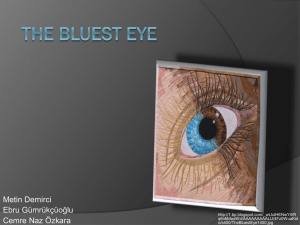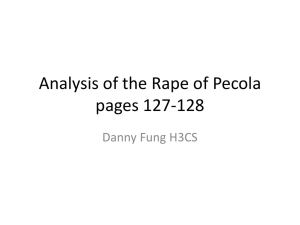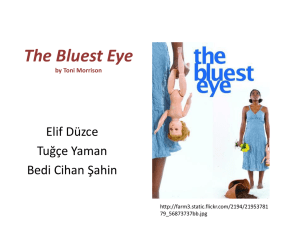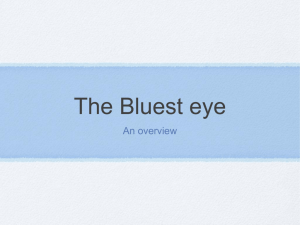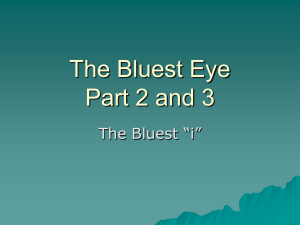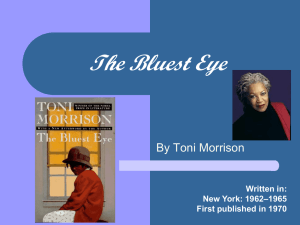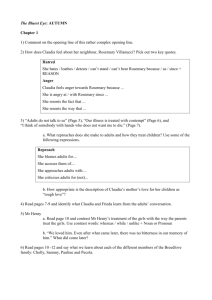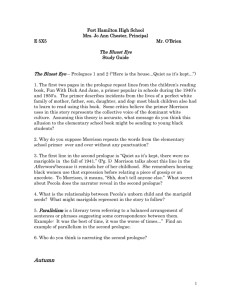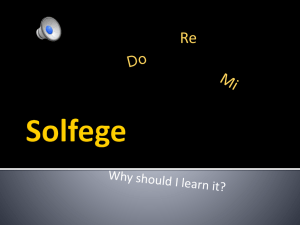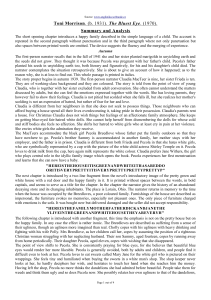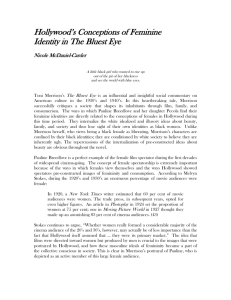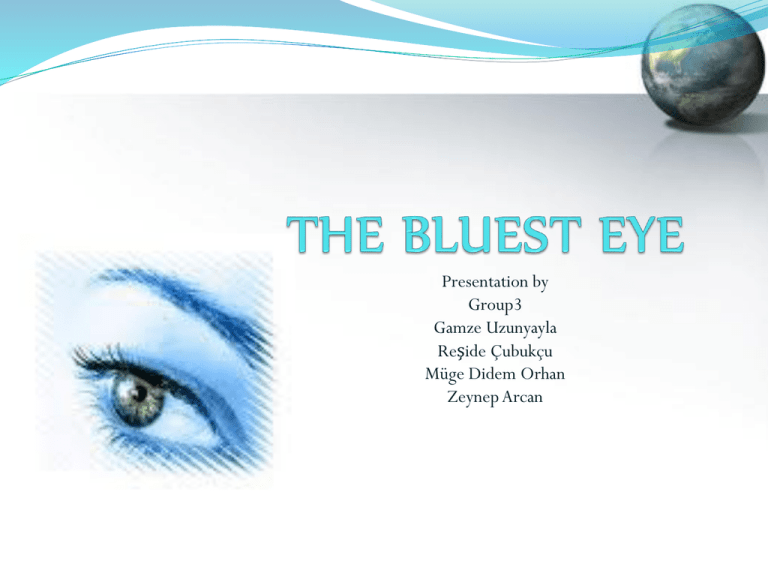
Presentation by
Group3
Gamze Uzunyayla
Reşide Çubukçu
Müge Didem Orhan
Zeynep Arcan
OUTLINE
1.Toni Morrison’s style;
Lyric Prose
Metaphors
Simile
Ironies
2.Cultural and Historical Contex;
Great Depression
3.Themes and Characters
The search for love
4.References
TONI MORRISON'S STYLE
Retrieved 10 may 2010;
http://wordbandit.files.wordpress.com/2009/02/morrison1.jpg
Rich, lyrical prose
Simile
Irony
Metaphor
Imaginary
“And cholly loverd her. I ‘m sure he did. He ,at any rate, was the one
who loved enough her, envelop her, give something of himself to her. But his
touch was fatal, and somehing he gave her filled the matrix of her agony with
death. Love is never any better than the lover.Wicked people love wickedly,
violent people love violently, weak people love weakly, stupid people love
stupidly, but the love of a free man is never safe.There is no gift for the
beloved.The lover alone possesses his gift of love.The loved one is shorn,
neutralized, frozen in the glare of the lover’s inward eye.”
(p.206)
“...longing for those hard times, yearning to be grown without “a thin di-ime
to my name.” I looked forward to the delicious time when “my man” would leave
me, when I would “hate to see that evening sun go down...” 'cause then I would
know “my man has left this town.” ”
(p.26)
ST. LOUIS BLUES
Retrieved 10 may 2010 from :
http://www.paulayickvintagebrass.com/wc%20handy.jpg
THE BLUEST EYE
Blue=color
Blue=glommy,sad
“Please make me disappear.”
(p.45)
“Each night, without fail, she
prayed for blue eyes”
(p.46)
Keep the reality, saddness
Retrieved 10 may 2010 from;
http://3.bp.blogspot.com/_J1ASwm5hEzE/Sd6bwaYpbiI/AAAAAA
AAAEk/tX4P9oLKjZg/s400/Bluest+eye.jpg
“We had dropped our seeds in our own little plot of black dirt
just as Pecola’s father had dropped his seed in his own plot
of black dirt.”
(p.6)
Could you give an another example of metaphor in the novel?
“Dolls we could destroy, but we could not destroy the honey voices of
parenst and aunts, the obedience in the eyes of our peers , the slippery
light in the eyes of our teacher when they encountered the Maureen Peals
world. ” (p.76)
“They fight this battle all the way to the grave.The laugh that is a little
too loud; the enunciation a little too round; the gesture a little too
generous.Thayhold their behind in for fear of sway too free; when they
wear lipstick, they never cover the entire mounth for fear of lips too thick,
and they worry, worry, worry about the edges of their hair.”
(p.83)
Mary Jane
“Smiling white face.Blonde hair in gentle disarray, blue eyes looking at
her out of a world of clean comfort.The eyes are petulant, michevious.To
Pecola they are simply pretty. She eats the candy, and its sweetness is
good.To eat the candy is somehow to eat the eyes, eat Mary Jane. Love
Mary Jane. Be Mary Jane.”
(p.49)
BREEDLOVE
Breed=produce
Breeding hate
Family member could not love each other.
Soaphead Church
write a letter to God (p.176)
vs.
poisioned dog
Pedophili
Is there any other irony in the
novel?
retrieved 10 may 2010 from;
http://www.theatermania.com/off-broadway/news/11-2006/the-bluest-eye_9412.html
THE GREAT DEPRESSION
Worldwide economic downturn (1929 -1939).
Decline in stock prices in USA
Foreign investors withdraw stocks
“Black Thursday,” October 24, 1929
Wall Street Crash – USA Stock Marked
Western World and USA as centre
Industrialized countries
Retrieved 9 may 2010 from ;
http://images.businessweek.com/ss/07/04/0426_dow/image/2_great_depression.jpg
Retrieved 9 may 2010 from;
http://www.doughroller.net/wp-content/uploads/2007/10/wall1.gif
Retrieved 9 may 2010 from ;
http://4.bp.blogspot.com/_KMjHfqqmal8/SZub2gCMfOI/AAAAAAAAA9A/YdH3RmWEeCc/s400/
Black_Tuesday_2.jpg
Stock Marked Crash
(Decline In Stock Price)
Led to
Declıne In Spendıng1)Declıne In Productıon
2)Declıne In Employment
UNEMPLOYMENT QUEUES
Retrieved 9 may 2010 from;
http://biggovernment.com/files/2010/03/Great-Depression-Unemployment-Line1.jpg
Retrieved 9 may 2010 from;
http://earthhopenetwork.net/unemployment_depression.jpg
EFFECTS OF CRISIS ON AFRICAN-AMERICAN
SOCIETY IN USA
Employment discrimination against African-Americans
LAST HIRED, FIRST FIRED!
Why were they last hired, first fired?
Because
• They are black
• Less educated
• Less skilled
FEDERAL SURVEY OF UNEMPLOYMENT
FEDERAL SURVEY OF UNEMPLOYMENT
What kind of problem mentioned in novel does unemployment
cause ?
Poverty
How does the unemployment creates differences between whites
and black? Do you remember any examples in the novel?
Retrieved 9 may 2010 from;
http://www.everyculture.com/multi/images/gema_01_img0008.jpg
WHITES’ WORLD
"We reached the Lake Shore Park, a city park laid out with rosebuds,
fountains, bowling greens, picnic tables. It was empty
now, but sweetly expectant of clean, white, well-behaved children
and parents who would play there above the lake in summer
before half-running, half-stumbling down the slope to the
welcoming water." (p.105)
Better life conditions than blacks( clean areas, freedom, healthy
places.. Etc.)
Welathy
Happiness
BLACKS’ WORLD
"Later we walk home, glancing back to see the great carloads
of slag being dumped, red hot and smoking, into the ravine
that skirts the steel mill.The dying fire lights the sky with a dull
orange glow. Frieda and I lag behind, staring at the patch of
color surrounded by black. It is impossible not to feel a shiver
when our feet leave the gravel path and sink into the dead grass
in the field." (p.10)
Unhealty life conditions (smoking, orange glow sky)
Poverty
NEGRO JOBS
Waiter, domestik servant and porter
White industries-steel, cooal, automobiles but with no
protection for blacks.
With minimum wages.
“ They agreed to marrt and go ‘way up north, where Cholly said steel mills
werebegging for workers.Young, loving and full of energy, they came to
Lorain, Ohio. Cholly found work in the steel mills right away, and Pauline
started keeping house.” (p. 116)
BLACK WOMANS
There were no discrimination for black women more than black
men.
Do you give an example about a working women in novel?!
Pauline works in a white family’s house.
THE SEARCH FOR LOVE
•
•
•
Why black people have to search for love?
Grow without love
Families are inadequate to give importance to their needs
Grow with lots of social and economic problems: racism, poverty
In the novel,
Different type of loves : Cholly’s love for his daughter
Cholly’s love for Pauline
Pecola’s love for having blue eyes
Pecola’s love for Mary Janes
CHOLLY’S SEARCH FOR LOVE
Why does Cholly become a violent man?
Whose fault is it?
The reasons: - His mother
- His father
left him when he was 4 days old
does not know him
The results: - Grow up with an aunt
- Grow up lack of mother and father’s love
“-I’m your boy.
-Something wrong with your head?Who told you to come after me?
-Nobody. I just thought … I mean, I was just wandering around, and
uh, my name is Cholly…
-Tell that bitch she get her money. Now, get the fuck outta my face!”
(p.156)
How does this conversation affect on Cholly’s personality?
Before conversation:
-He wants to touch his father’s head
-He sees in his father’s body his own body
After conversation:
-The possibility of a crual man
-The possibility of an agressive man
-The possibility of a violent man
Being drunk , rapest
“Love is never any better than the lover.Wickled people love wickedly,
violent people love violently, weak people love weakly, stupid people
love stupidly but the love of a free man is never safe.”
(p. 206)
What does Morrison want to mention at this quote?
THE PESIMISTIC
POINT OF VIEW
THE EMPATHETIC
POINT OF VIEW
Cholly as a
rapist
Cholly as a
free man
-Never safe
-Good people
deserve good loves
-Life is cruel to him
Not free to love, sex
-Bad people love
badly
PAULINE’S SEARCH FOR LOVE
Which conditions change Mrs. Breedlove’s happiness?
The conditions: -impaled her foot on a nail: crippled
white folks
-lack of love from her family
-grows up individually
-lost her front tooth
-has a drunk husband
-suffers from cultural conflicts: she was not used to
PAULINE’S FANTASIES
“Fantasies about men and love and touching were drawing her mind
and hands away from her work.”
(p.113)
“For the first time Pauline felt that her bad foot was an asset.”
(p.116)
Does she find her ideal love?
Is there any difference between Pauline’s and Cholly’s
early and later relationship?
BREEDLOVE’S LOVE CHANGED
“Money became the focus of all their discussion, hers for clothes, his for
drink.”
(p.118)
How does Pecola’s birth affect their relationship?
“He began to drink less and come home more often.They eased back into a
relationship more like the early days of their marriage, when he asked if
she were tired or wanted him to bring her something from the store. […]
But the loneliness in those two rooms had not gone away. ”
(p.121)
PECOLA’S SEARCH FOR LOVE
“-Is it true that I can have a baby now?
-Sure you can.
-But… how?
-Oh, somebody has to love you.
There was a long pause in which Pecola and I thought this over. It would
involve, I supposed,“my man,” who before leaving me, would love me. But
there weren’t any babies in te songs my mother sang. Maybe that’s why
the women were sad: the men left before they could make a baby.
Then Pecola asked a question that had never entered my mind.“How do you
do that? I mean, how do you get somebody to love you?” but Frieda was
asleep. And I didn’t know.”
(p.32)
o How is love defined in this conversation according to
a woman?
First has a lovely relationship, then be abandoned.
o In the novel, whose relationships are like this?
Breedloves
PECOLA AND PAULINE’S RELATIONSHIP
Relationship with her mother:
“Pecola, like Sammy and Cholly, always called her mother Mrs. Breedlove.”
(p.43)
“Her calling Mrs. Breedlove Polly, when even Pecola called her mother Mrs.
Breedlove, seemed reason enough to scratch her.“
(p.108)
Their relationship is different from the typical mother- daughter
relationship.
Pauline accepts her ugliness. Because she feels the same.
Pauline brings up Pecola without love.
REFERENCES:
Robbins, L. (1934). The Great Depression. New York: Macmillan Company
Morrison, T. (1993). The Bluest Eye. New York: Vintage books.
Sundstrom W.A. (1992). The Journal of Economic History. Cambridge: Cambridge University
Press. (pp. 415- 429).
Encyclopaedia Britannica. Black history retrieved 9 may 2010 from
http://www.britannica.com/blackhistory/article-234447
Moses C. (Winter, 1999), African American Review, Vol. 33, No. 4 pp. 623-637
Published by: Indiana State University
Retrieved 10 may 2010 from;
http://academicearth.org/lectures/toni-morrison-the-bluest-eye
Retrieved 8 may 2010 from;
http://academic.brooklyn.cuny.edu/english/melani/cs6/eye61.html

